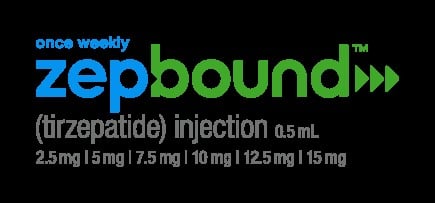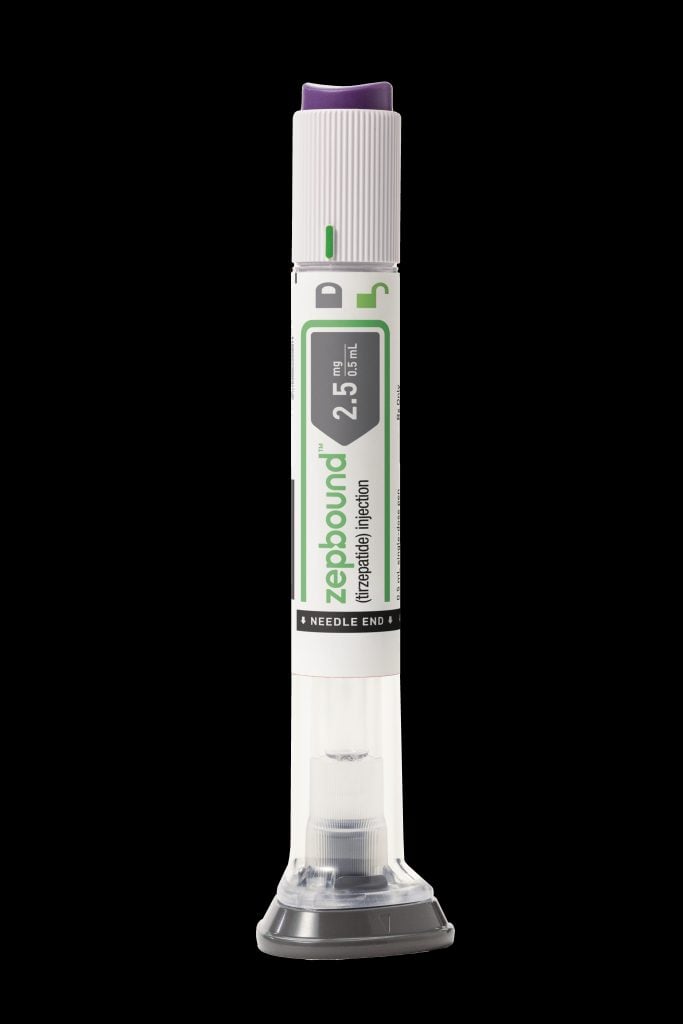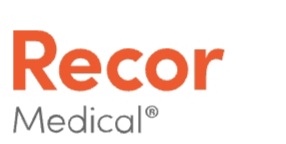
An Endocrine News roundup of the week’s pharmaceutical news, breakthroughs, and general information. *
FDA Approves Lilly’s Zepbound™ (tirzepatide) for Chronic Weight Management
On November 8, the U.S. Food and Drug Administration (FDA) approved Eli Lilly and Company’s (NYSE: LLY) Zepbound™ (tirzepatide) injection, the first and only obesity treatment of its kind that activates both GIP (glucose-dependent insulinotropic polypeptide) and GLP-1 (glucagon-like peptide-1) hormone receptors. Zepbound is indicated for adults with obesity (with a BMI of 30 kg/m2 or greater), or those who are overweight (with a BMI of 27 kg/m2 or greater) and also have weight-related medical problems such as hypertension, dyslipidemia, type 2 diabetes mellitus, obstructive sleep apnea or cardiovascular disease, to lose weight and keep it off. It should be used with a reduced-calorie diet and increased physical activity. Zepbound should not be used with other tirzepatide-containing products or any GLP-1 receptor agonist medicines, and it has not been studied in patients with a history of pancreatitis, or with severe gastrointestinal disease, including severe gastroparesis.
The approval was based on results from the phase 3 SURMOUNT-1 and SURMOUNT-2 trials. In SURMOUNT-1, a study in 2,539 adults with obesity, or excess weight and weight-related medical problems not including diabetes, people taking Zepbound as an adjunct to diet and exercise experienced substantial weight loss compared with placebo at 72 weeks. At the highest dose (15 mg), people taking Zepbound lost on average 48 lb., while at the lowest dose (5 mg), people lost on average 34 lb. (compared to 7 lb. on placebo).
Additionally, one in three patients taking Zepbound at the highest dose lost over 58 lb. (25% of body weight), compared to 1.5% on placebo, according to data not controlled for type 1 error. The average starting weight was 231 lb.
While not approved to treat these conditions, in a clinical trial, people who dieted, exercised and took Zepbound for the treatment of obesity or overweight with weight-related medical problems observed changes in cholesterol and reductions in blood pressure and waist size.

“Unfortunately, despite scientific evidence to the contrary, obesity is often seen as a lifestyle choice – something that people should manage themselves,” said Endocrine Society member Leonard Glass, MD, senior vice president global medical affairs, Lilly Diabetes and Obesity. “For decades, diet and exercise have been a go-to, but it’s not uncommon for a person to have tried 20 – 30 times to lose weight with this approach. Research now shows that the body may respond to a calorie-deficit diet by increasing hunger and reducing feelings of fullness, making weight loss more difficult. Lilly is aiming to eliminate misperceptions about this disease and transform how it can be managed.”
Zepbound use may be associated with gastrointestinal adverse reactions, sometimes severe. The most commonly reported adverse events (observed in ≥ 5% of clinical trial participants) were nausea, diarrhea, vomiting, constipation, abdominal pain, dyspepsia, injection-site reactions, fatigue, hypersensitivity reactions, eructation, hair loss and gastroesophageal reflux disease. In studies, most nausea, diarrhea, and vomiting occurred when people increased their dose – but the effects generally decreased over time.
In studies, gastrointestinal side effects were more common in people taking Zepbound than people taking placebo, and people taking Zepbound were more likely than those on placebo to stop treatment because of these side effects. The label for Zepbound includes a Boxed Warning regarding thyroid C-cell tumors. Zepbound is contraindicated in patients with a personal or family history of medullary thyroid carcinoma, in patients with Multiple Endocrine Neoplasia syndrome type 2, and in patients with known serious hypersensitivity to tirzepatide or any of the excipients in Zepbound. See Important Safety Information below and full Prescribing Information and Medication Guide.
“Far too many hurdles continue to prevent people living with obesity from accessing obesity treatments that could lead to significant weight loss,” said Mike Mason, executive vice president and president, Lilly Diabetes and Obesity. “Broader access to these medicines is critical, which is why Lilly is committed to working with healthcare, government and industry partners to ensure people who may benefit from Zepbound can access it.”
“For decades, diet and exercise have been a go-to, but it’s not uncommon for a person to have tried 20 – 30 times to lose weight with this approach. Research now shows that the body may respond to a calorie-deficit diet by increasing hunger and reducing feelings of fullness, making weight loss more difficult. Lilly is aiming to eliminate misperceptions about this disease and transform how it can be managed.”
Leonard Glass, MD, senior vice president global medical affairs, Lilly Diabetes and Obesity
Zepbound is expected to be available in the U.S. by the end of the year in six doses (2.5 mg, 5 mg, 7.5 mg, 10 mg, 12.5 mg, 15 mg) at a list price of $1,059.87, which is approximately 20% lower than semaglutide 2.4 mg injection for weight loss. List price does not reflect the typical out-of-pocket cost to patients given insurance coverage and discounts. Lilly is putting a commercial savings card program in place that will help people who may benefit from Zepbound better access it.
- People who are commercially insured with coverage for Zepbound may be eligible to pay as low as $25 for a one-month or three-month prescription.
- People who are commercially insured without coverage for Zepbound may be eligible to pay as low as $550 for a one-month prescription of Zepbound, approximately 50% lower than the list price.
People may begin using the savings card program in the days following product availability at U.S. pharmacies. To learn more about these programs, or to sign up to receive the latest news, please visit www.Zepbound.lilly.com. Terms and conditions apply.
Tirzepatide is also under regulatory review for weight management in Europe, China, the United Kingdom and several additional markets.
Aldosterone Synthase Inhibitor on Top of Empagliflozin Delivers Promising Phase II Trial Results
On November 3, Boehringer Ingelheim announced promising 14-week Phase II data for BI 690517, a novel selective aldosterone synthase inhibitor (ASi).
The results showed a significant reduction of albuminuria, a marker of kidney damage, by up to 39.5% when BI 690517 was given on top of empagliflozin, a sodium glucose cotransporter (SGLT2) inhibitor, vs. placebo. This is the first clinical trial testing this novel treatment class on top of standard of care including empagliflozin in people with chronic kidney disease (CKD), which affects more than 850 million people worldwide. The findings were presented as a high-impact clinical trial at the American Society of Nephrology (ASN)’s Kidney Week 2023.
BI 690517 has a novel mode of action that effectively and sustainably inhibits aldosterone synthase, an enzyme that controls the final rate-limiting steps in aldosterone synthesis. Excessive aldosterone levels cause organ damage and promote cardio-renal-metabolic conditions such as hypertension, chronic kidney disease or heart failure.

“This unique trial testing a selective aldosterone synthase inhibitor on top of standard of care including SGLT2 inhibition, showed positive and clinically relevant efficacy. Using BI 690517 along with SGLT2 inhibition may offer the potential for additive kidney benefits while possibly mitigating hyperkalemia risk,” said Katherine Tuttle, principal study investigator and professor of medicine in the Nephrology Division and Kidney Research Institute at the University of Washington. “Additional CKD treatments are urgently needed to reduce residual risks of disease progression and serious complications.”
While aldosterone synthase inhibition can lead to moderate elevation of serum potassium, this study suggests there is potential that empaglifozin’s mechanism of action can mitigate the risk of hyperkalemia when given as a background therapy. This effect is of high clinical importance since severe hyperkalemia may lead to changes in medical therapy or hospitalization. As a novel drug class, BI 690517, on top of empagliflozin, may address this critical unmet medical need.
A key secondary endpoint in the Phase II trial was a clinically meaningful reduction in UACR (≥30%) which was achieved by up to 70% of patients treated with BI 690517 on top of empagliflozin. Based on analyses assessing albuminuria change as a predictive indicator, these changes may translate into risk reductions for clinical kidney disease events by at least 30%.
“These encouraging Phase II data not only demonstrate our commitment to developing innovative and transformational treatments for people living with cardio-renal-metabolic conditions but also have the potential to decrease the global burden of these interconnected diseases,” said Carinne Brouillon, head of Human Pharma, Boehringer Ingelheim. “With over 1 billion people worldwide affected by these conditions, the potential to help reduce the pressure on healthcare systems and patients is immense. We are proud to be leading the way in this field and are excited to move forward with the upcoming Phase III trial to further investigate the potential of this novel compound on top of standard of care including empagliflozin.”
In 2024, Oxford Population Health and Boehringer Ingelheim’s new, international Phase III EASi-KIDNEYTM trial will begin recruitment. The trial aims to definitively test the efficacy and safety of BI 690517 given on top of standard of care, including empagliflozin. EASi-KIDNEYTM will recruit and follow about 11,000 participants with established CKD, at risk of kidney disease progression, using Oxford Population Health’s streamlined model.
BI 690517 was generally well tolerated without unexpected safety signals. Dose-dependent modest increases in serum potassium levels were observed with BI 690517, which were slightly ameliorated in the presence of empagliflozin. Hyperkalemia occurred at a rate typical for a CKD population, and most episodes did not require medical treatment or BI 690517 discontinuation.
First Renal Denervation System to Treat Hypertension Approved by the FDA
On November 7, Recor Medical, Inc. and its parent company, Otsuka Medical Devices, Ltd., announced that the U.S. Food and Drug Administration (FDA) has approved Recor’s Paradise™ Ultrasound Renal Denervation (RDN) system for the treatment of hypertension.
The Paradise system is intended as an adjunctive treatment option when lifestyle changes and medications have not adequately controlled a patient’s blood pressure. It is a first-of-its-kind ultrasound-based RDN technology designed to lower blood pressure by denervating the sympathetic nerves surrounding the renal arteries, reducing the overactivity that can lead to hypertension. The Paradise system delivers two to three doses of 360-degree ultrasound energy — lasting seven seconds each — through each of the main renal arteries to the surrounding nerves. The Paradise catheter features the exclusive HydroCooling™ system, which circulates sterile water through the balloon catheter during the procedure to help protect the renal artery wall.
Approval of the Paradise system follows Recor’s positive FDA Advisory Committee Panel in August 2023. Earlier this year, results from Recor’s U.S. pivotal study, the RADIANCE™ II Randomized Clinical Trial, were published in the Journal of the American Medical Association (JAMA). In the study, the Paradise Ultrasound RDN system met both the primary safety and effectiveness endpoints without any major adverse events.

“This FDA approval is the culmination of years of technical research and rigorous clinical studies,” said Lara Barghout, President and CEO of Recor Medical. “We are grateful to the patients who participated in the studies and to the clinical trial investigator teams whose diligence and dedication made FDA approval possible. We look forward to making this technology available to physicians and their patients nationwide.”
Recor has been focused on developing and testing the Paradise Ultrasound RDN system for the treatment of hypertension since 2009. The RADIANCE global program studied the Paradise system in three independently powered, sham-controlled, randomized clinical trials in over 500 patients with uncontrolled hypertension: RADIANCE II and RADIANCE-HTN SOLO, which studied patients with mild-moderate hypertension in an “off-meds” setting, and RADIANCE-HTN TRIO, which studied patients with resistant hypertension on standardized triple antihypertensive therapy. Each trial met its prescribed primary efficacy endpoint with a favorable safety profile consistently observed following ultrasound RDN treatment.
“Despite the longstanding availability of dozens of affordable anti-hypertensive medications, blood pressure control rates in the United States are alarmingly low and falling. Given the significant blood pressure reductions seen in the ultrasound renal denervation trials, the Paradise Ultrasound Renal Denervation system offers a much-needed advancement in our currently available options to control hypertension,” said site principal investigator Naomi Fisher, MD, Associate Professor of Medicine, Harvard Medical School, and Director of Hypertension Service and Hypertension Innovation, Division of Endocrinology, Diabetes and Hypertension at Brigham and Women’s Hospital. “uRDN has proven efficacy in patients with truly resistant hypertension, a population for whom medication therapy often fails. It is also effective in patients with mild to moderate hypertension who cannot tolerate enough medication to control their blood pressure.”
Hypertension is the leading contributor to disease burden worldwide, resulting in increased cardiovascular morbidity and mortality, poor quality of life, and higher costs to health systems. The Paradise Ultrasound RDN system previously received CE mark and has been successfully introduced in Europe and is an investigational device in Japan.
*Inclusion in Pharma Fridays does not suggest an endorsement by Endocrine News or the Endocrine Society.

